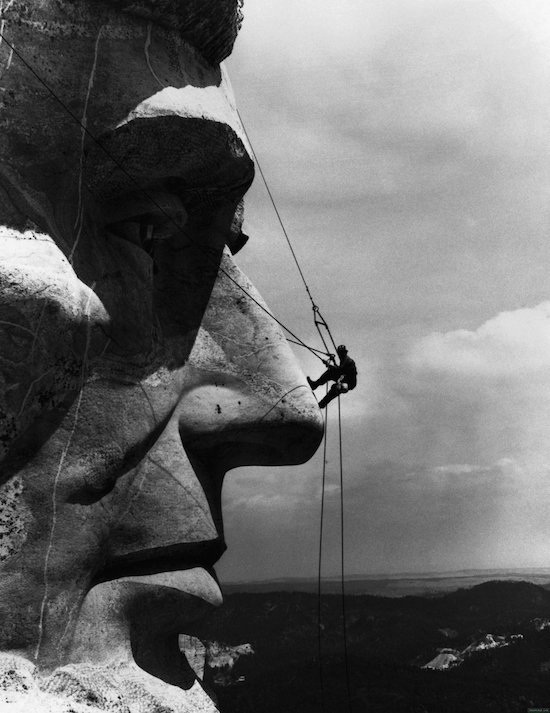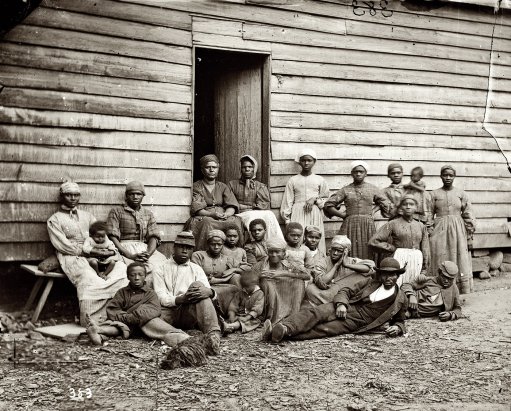
Gutzon Borglum Mount Rushmore, Repairing Lincoln’s nose 1962

Dr. D figured his last missive was a bit heavy handed. So he went for something lighter this time. A penance, a doctor’s guide: “It’s hard enough to find a candidate that will even promise to do something right so it doesn’t help that they do the opposite 90% of the time.”

Dr. D:
Who wrote “We hold these Truths to be self-evident, that all Men are created equal”? Jefferson, a slave owner.
Who was one of the most ardent Abolitionists? Alexander Hamilton.
Was he a slave owner? Yes.
Who won the election of 1824? No one, it was decided by the House of Representatives.
So which party lost? None: all four candidates were Democratic-Republicans.
In response, Andrew Jackson, a slave owner, created the Democratic Party.
Jackson created the Democratic Party as an anti-bank, anti-oligarch, states-rights platform the Tea Party would recognize.
Martin Van Buren, a Democrat, created the first concentration camp for Cherokee Indians in 1838.
Those 17,000 Cherokees owned 2,000 slaves.
Did Lincoln create the Republican Party? No, it was an amalgamation of failed parties: Lincoln was their 1st candidate.
What was the Lincoln campaign of 1860? Non-interference in state slavery.
Why? The decision of Dred Scott in 1857, a slave owned by abolitionists in a state he did not reside. Overturning 250 years of history, the case determined that no slave could ever become a citizen, i.e. freed.
Who was the best known Confederate General? Stonewall Jackson.
What did he do when he sided with the Southern cause? Freed his slaves.
Who else was a top Confederate General? William Mahone.
What did he do? He was the creator of the most successful interracial alliance in the post-war South. His name was purged first by Southern Democrats (for integration), then by modern Democrats (for being a Confederate).
Woodrow Wilson (D) ran an anti-collectivism, limited government, anti-monopoly, anti-bank campaign in 1912. He created the Federal Reserve and is known for founding the modern welfare state.
Wilson was re-elected on the slogan “He Kept Us Out of War.” He immediately forced the reluctant nation into WWI.
Herbert Hoover, as Secretary of Commerce under Calvin Coolidge during the Crash of ’21, demanded economic aid and bailouts, but Coolidge, “the great refrainer,” refused. The market immediately recovered.
Hoover was President during the Crash of ’29. He gave unprecedented bailouts to help the economy recover. It never did.
Roosevelt campaigned against Hoover for being “ the greatest spending Administration in peacetime in all our history.” He outspent Hoover tenfold.
Did Roosevelt’s “New Deal,” the greatest stimulus and spending program up to that time, end the Great Depression? No. It was going strong in 1939.
What did Roosevelt campaign on? He promised to keep us out of war in Europe.
Who was Time’s Man of the Year in 1938? Adolf Hitler.
Who was Man of the Year in 1939? Joseph Stalin.
1942? Joseph Stalin.
Wars under “anti-war” Democratic Party: 93 years, 46.5%. 625K deaths since 1864.
Wars under “pro-war” “Republican” Party: 107 Years 53.5%. 12K deaths since 1864.
Who voted for the 1964 Civil Rights Act? Republicans 80% vs. Democrats 69%.
Who filibustered it? Southern Democrat Strom Thurmond.
Who signed it? Lyndon Johnson, a southern Democrat.
Where did Thurmond go? The GOP, who had voted against him and against southern segregation.
What did Richard Nixon campaign on? “Law and Order” and a “secret plan” to exit Vietnam. He immediately bombed Cambodia and was later impeached for a burglary.
Who said “the soundest way to raise revenues in the long run is to cut rates now” and “Every dollar released from taxation that is spent or invested will help create a new job and a new salary” ? John F. Kennedy.
Who gave the greatest modern tax cut? John F. Kennedy (income and capital gains, signed by Johnson).
Who most increased the postwar Federal deficit? Ronald Reagan 186%.
Who most increased taxes? Ronald Reagan, 1982 (as % of GDP, excluding Obamacare and Johnson’s one-year tax).
Who called young blacks “Superpredators”? Hillary Clinton, 1996.
Who put the most black men in jail? Bill Clinton, under the 1994 Violent Crime Control Act.
Who cut welfare most? Bill Clinton, 1996 Personal Responsibility and Work Act.
Who was called the first “Black President”? Bill Clinton (“white skin notwithstanding, this is our first black President. Blacker than any actual black person who could ever be elected in our children’s lifetime.” –Toni Morrison, 1998. I swear this is true).
What was George W. Bush’s platform? Smaller, less-invasive government, lower taxes, and no foreign wars.
Who are the Neoconservatives? “Liberal hawks who became disenchanted with the pacifist foreign policy of the Democratic Party”.
Where did these Liberal Democrats finally prosper? Under G.W. Bush and on Fox News, e.g. Bill Kristol.
Which President won the Nobel Peace Prize? Barack Obama. (As did Theodore Roosevelt, Woodrow Wilson and Jimmy Carter)
What was his legacy? War every day of all eight years, with +50,000 official strikes in Afghanistan, Pakistan, Libya, Yemen, Somalia, Iraq, and Syria and unofficial attacks in Ukraine, Sudan, Niger, Cameroon, Uganda, and elsewhere, as well as 3,000 drone deaths.
Wow, anything else? Due to his intervention, Obama, the first black president, caused the creation of an open-air black slave market in Libya.
Who campaigned advocating a Syrian no-fly zone expected to cause WWIII with Russia? Hillary Clinton (D).
Who campaigned for peace talks and de-escalation with Russia? Donald Trump (R).
Who sent 164 missiles into Russian ally Syria? Donald Trump (R).
Who advocated against the recent attacks? “Far-right” speakers Rand Paul and Tucker Carlson of Fox News.
Who advocated for the attacks? “Left” speakers Fareed Zakaria, and Rachel Maddow with left media Slate and Mother Jones.
What was the actual breakdown? 22% of GOP supported Syrian airstrikes in 2013 vs 86% for the same strikes in 2017.
And on and on. Got it? Know which side you’re on? History, party platforms, personal beliefs, economy, all clear?
“It ain’t what you don’t know that gets you into trouble. It’s what you know for sure that just ain’t so.”
P.S. Mark Twain never said this.










